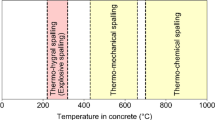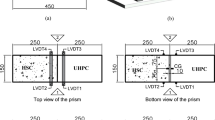Abstract
Recently, RILEM TC 162-TDF has proposed equivalent,f eq , and residual,f R , flexural tensile strength parameters to characterize and simulate the post-cracking behaviour of steel fibre reinforced concrete (SFRC) structures. In the current work, more than two hundred flexural tests are carried out according to the RILEM TC 162-TDF recommendations and the corresponding values off eq andf R parameters are evaluated. In series of specimens reinforced with fibres of a distinct length/diameter ratio, similar values off eq andf R parameters were obtained in these series. Although a strong correlation betweenf eq andf R was determined, a larger scatter off R values was observed thereby revealingf eq to be more appropriate for design purposes. A numerical strategy involving a cross sectional layered model and an inverse analysis was developed to evaluate the post-cracking stress-strain and the stress-crack opening diagrams for the tested SFRC. This strategy was also used to determine a relation between the post-cracking strain, ɛpcr, and the crack opening displacement,w, (ɛpcr=w/L p ) which is useful for evaluating the crack opening when numerical strategies based on a stress-strain approach are used. The obtainedL p values range from half the specimen cross section height to half the distance between the tip of the notch and the top of the cross section.
Résumé
Récemment, pour caractériser et simuler le comportement post-fissuration en traction du béton renforcé des fibres d'acier, la Commission Technique 162-TDF de la RILEM a proposé des paramètres désignés par résistance équivalente, feq, et résistance résiduelle, fR, à la contrainte en flexion. Dans le travail présent, des valeurs de ces paramètres sont obtenues sur plus de deux cents essais de flexion effectués en accord avec les recommandations du TC 162-TDF de la RILEM. Des valeurs semblables de feq et fR ont été obtenues dans des séries d'éprouvettes renforcées avec des fibres d'un rapport longueur/diamètre distinct. Bien qu'une forte corrélation entre feq et fR ait été déterminée, une plus grande dispersion de valeurs du fR a été observée, en démontrant que feq est plus approprié pour les buts du projet. Pour évaluer les diagrammes contrainte-déformation et contrainte-ouverture après fissuration, une stratégie numérique a été développée, en utilisant un modèle de section et en effectuant une analyse inverse. Cette stratégie a aussi été utilisée pour déterminer une relation entre la contrainte après fissuration, ɛpcr, et l'ouverture de fissure, w, (ɛpcr=w/L p ) utile pour évaluer l'ouverture de la fissure quand les stratégies numériques sont basées sur une approche contrainte-déformation. Les valeurs de Lp obtenues ont varié entre la demi-hauteur de la section de l'éprouvette et la demi-distance entre l'extrémité de l'entaille et le sommet de la section.
Similar content being viewed by others
References
ASTM C 1018, ‘Standard test method for flexural toughness and first crack strength of fiber reinforced concrete (using beam with third-point loading (4.02)’, American Society of Testing and Materials, Philadelphia, 1990, 637–644.
Japan Society of Civil Engineers, ‘Method of test for flexural strength and flexural toughness of fiber reinforced concrete’, Standard, SF-4, 1984, 58–66.
Gopalaratnam, V.S.et al., ‘Fracture toughness of fiber reinforced concrete’,ACI Materials Journal 88 (4) (July–Aug. 1991) 339–353.
Banthia, N. and Trottier, J.-F., ‘Test methods for flexural toughness characterization of fiber reinforced concrete: some concerns and a proposition’,ACI Materials Journal 92 (1) (Jan.–Feb. 1995) 48–57.
Banthia, N., and Trottier, J.-F., ‘Concrete reinforced with deformed steel fibres, Part II: Toughness characterization’,ACI Materials Journal 92 (2) (Mar.–Apr. 1995) 146–154.
Vandewalle, L.et al., ‘Test and design methods for steel fiber reinforced concrete. Recommendations for bending test’,Mater. Struct. 33 (225) (Jan.–Feb. 2000) 3–5.
Vandewalle, L.et al., ‘Test and design methods for steel fiber reinforced concrete. Recommendations for σ-ε design method’,Mater. Struct. 33 (226) (Mar. 2000) 75–81.
Vandewalle, L.et al., ‘Test and design methods for steel fibre reinforced concrete—Final Recommendation’,Mater. Struct. 35 (253) (Nov. 2002) 579–582.
Vandewalle, L.et al., ‘Test and design methods for steel fibre reinforced concrete—σ-ε design method—Final Recommendation’,Mater. Struct. 36 (262) (Oct. 2003) 560–567.
Barros, J.A.O. and Antunes, J.A.B., ‘Experimental characterization of the flexural behaviour of steel fibre reinforced concrete according to RILEM TC 162-TDF recommendations’, Proceedings of the RILEM TC 162-TDF Workshop, Edited by B. Schnütgen and L. Vandewalle (March 2003) 77–89.
Robins, P., Austin, S. and Jones, P., ‘Pull-out behaviour of hooked steel fibres’,Mater. Struct. 35 (251) (Aug. 2002) 434–442.
Gettu, R. and Barragán, B.E., ‘Direct tension test and interpretation’, Proceedings of the RILEM TC 162-TDF Workshop, Edited by B. Schnütgen and L. Vandewalle (March 2003) 15–30.
Kooiman, A.G., ‘Modelling steel fibre reinforced concrete for structural design’, Ph.D. Thesis, Delft Univ. of Technology, 2000.
Rosenbusch, J. and Teutsch, M., ‘Shear design with σ-ε-method’, Proceedings of the RILEM TC 162-TDF Workshop, Edited by B. Schnütgen and L. Vandewalle (March 2003) 105–117.
Vandewalle, L.et al., ‘Test and design methods for steel fiber reinforced concrete. Design of steel fibre reinforced using σ-ω method: principles and applications’,Mater. Struct. 35 (249) (Jun. 2002) 262–278.
Barros, J.A.O. and Sena-Cruz, J.M., ‘Fracture energy of steel fibre reinforced concrete’,Journal of Mechanics of Composite Materials and Structures 8 (1) (Jan.–Mar. 2001) 29–45.
Barros, J.A.O. and Figueiras, J.A., ‘Nonlinear analysis of steel fibre reinforced concrete slabs on grade’,Computers & Structures 79 (1) (Jan. 2001) 97–106.
Author information
Authors and Affiliations
Rights and permissions
About this article
Cite this article
Barros, J.A.O., Cunha, V.M.C.F., Ribeiro, A.F. et al. Post-cracking behaviour of steel fibre reinforced concrete. Mat. Struct. 38, 47–56 (2005). https://doi.org/10.1007/BF02480574
Received:
Accepted:
Issue Date:
DOI: https://doi.org/10.1007/BF02480574




